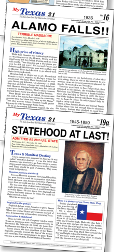Many years ago, I discovered an early version of the My California course, but it seemed to have disappeared. Now I find that author Robert C. Law has updated and improved the original My California course, and he has also created parallel courses for Illinois, Indiana, and Texas. These courses are targeted toward fourth graders since that is typically the year in which students study state history.
While I received My Texas for review, the layout of all four courses is similar. The course material is presented in a newspaper format rather than in a textbook. There are from 27 to 33 four-page issues for each course. (Occasionally, there are two issues for one week.) Each issue is laid out as a series of topical articles with illustrations, somewhat similar to the layout of a newspaper. Occasional activities are included where students write answers directly on their pages. “Reaction Time” questions at the end of each issue serve as comprehension and application questions.
Each set of student issues comes in a sturdy slip case. You might want to remove the three tests included in each student packet until you need them, but otherwise, students can each have their own slipcase with all of their issues. Of course, if you are concerned about students losing future issues, you can keep them to dole out as needed.
Issues are written in chronological order so students learn about events in the order in which they occurred. Contemporaneous events that happened beyond the state’s borders are sometimes included. The first issue of each state’s course carries similar foundational articles about Columbus’ voyages of discovery as well as about using a globe, reading maps, and understanding compass directions. This issue also introduces the state and its location in relation to neighboring states.
After the first issue, course content begins to differentiate significantly. Each course covers state history including political, cultural, industrial, infrastructure, and religious developments. Most of the time the format necessarily limits the amount of time devoted to each topic. While this abbreviated coverage might annoy adults, it is probably fine for fourth graders. You can always jump off into further study of a topic with other resources if time permits.
Issues sometimes incorporate articles or comments regarding principles, attitudes, and motivation. For example, the “Life is not a game!” article in the final issue of My Texas urges students to understand personal interactions, to choose their words wisely, to be thoughtful about their decisions. While these articles all tie into the issues' themes, you need not use all of them.
The teacher’s manual for each course is contained in a binder. It has brief explanatory information at the front, then presents each issue as a lesson that will span a week. You might condense the time for weeks when there are two issues, but you could also spread out lessons beyond one week if needed.
Issues as they appear in the teacher’s manual are missing the illustrations that appear in student issues. However, teaching notes are aligned in a column next to the articles to which they apply. These notes include additional comments on a topic, answer keys, and suggestions for activities, discussions, and field trips.
The teacher’s manual also has some copy masters, primarily for map work but also for games. In My Texas, the “Plan Ahead” game helps familiarize students with compass directions while also helping them learn how difficult it was for battle commanders to accurately predict where the enemy would be even a day or two in the future. “Headline” cards at the back of the My Texas binder can be used for games, for review, or for constructing a timeline. Directions for all of these options are in the binder.
The courses are best used in an interactive environment. A group class is ideal, but one-on-one will also work. The parent or teacher leading the course has the opportunity to make each course livelier with discussion and activities, but it all depends upon how much time and effort they want to invest.
Students easily overwhelmed by a textbook might find the individual issues of these courses more user-friendly. Articles are often written in more of a narrative fashion rather than in textbook language. This style of presentation for the material is also likely to be appealing to fourth graders.








